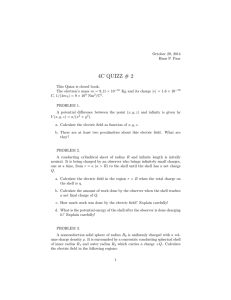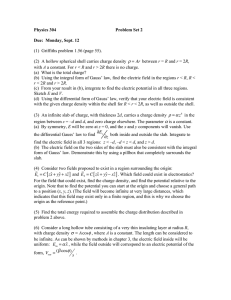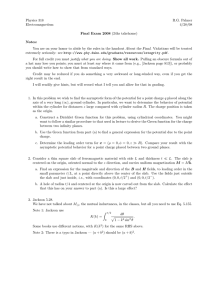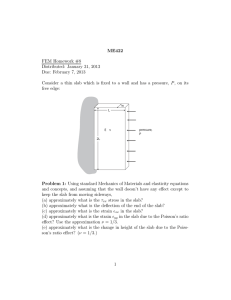Phased Construction
advertisement
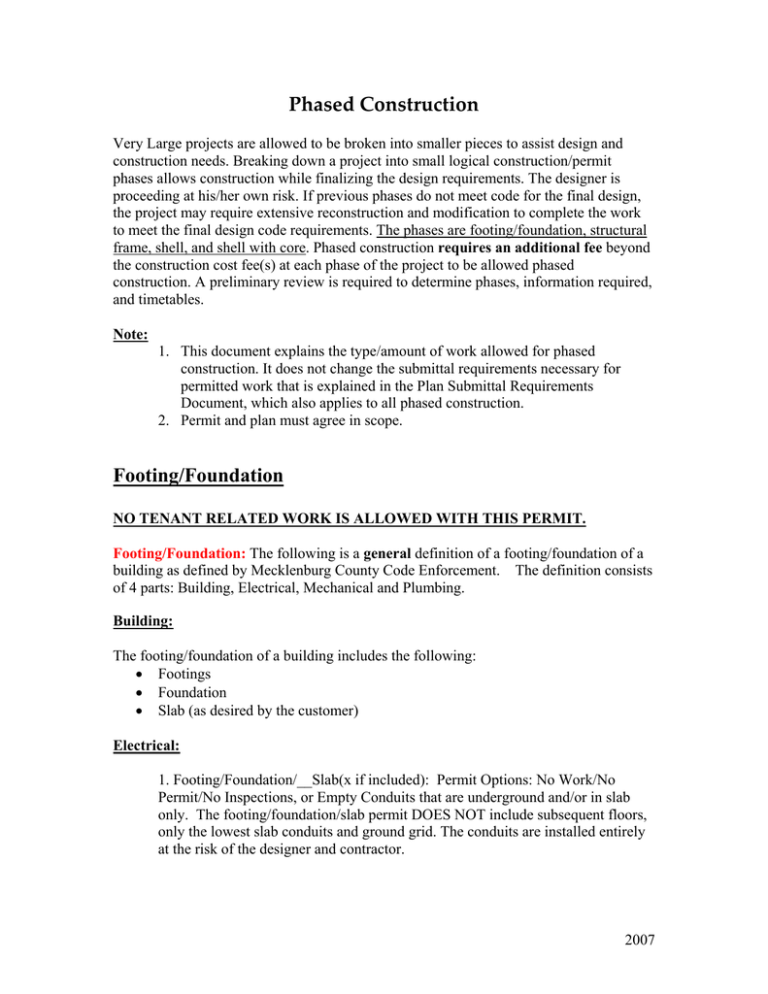
Phased Construction Very Large projects are allowed to be broken into smaller pieces to assist design and construction needs. Breaking down a project into small logical construction/permit phases allows construction while finalizing the design requirements. The designer is proceeding at his/her own risk. If previous phases do not meet code for the final design, the project may require extensive reconstruction and modification to complete the work to meet the final design code requirements. The phases are footing/foundation, structural frame, shell, and shell with core. Phased construction requires an additional fee beyond the construction cost fee(s) at each phase of the project to be allowed phased construction. A preliminary review is required to determine phases, information required, and timetables. Note: 1. This document explains the type/amount of work allowed for phased construction. It does not change the submittal requirements necessary for permitted work that is explained in the Plan Submittal Requirements Document, which also applies to all phased construction. 2. Permit and plan must agree in scope. Footing/Foundation NO TENANT RELATED WORK IS ALLOWED WITH THIS PERMIT. Footing/Foundation: The following is a general definition of a footing/foundation of a building as defined by Mecklenburg County Code Enforcement. The definition consists of 4 parts: Building, Electrical, Mechanical and Plumbing. Building: The footing/foundation of a building includes the following: • Footings • Foundation • Slab (as desired by the customer) Electrical: 1. Footing/Foundation/__Slab(x if included): Permit Options: No Work/No Permit/No Inspections, or Empty Conduits that are underground and/or in slab only. The footing/foundation/slab permit DOES NOT include subsequent floors, only the lowest slab conduits and ground grid. The conduits are installed entirely at the risk of the designer and contractor. 2007 2. Empty Conduits in decks: If above the lowest slab conduit is desired show type, size, location. Permitting is required for each floor individually. The conduits are installed entirely at the risk of the designer and contractor. Mechanical: NO HVAC EQUIPMENT, FLUES OR GAS PIPING ABOVE GRADE WILL BE ALLOWED. The Mechanical Plans Reviewer or Mechanical Chief may allow exceptions on a case by case basis. Plumbing: Plumbing is limited to the building drain and associated piping below the concrete slab. NO PIPING EQUIPMENT OR FIXTURES ABOVE THE SLAB ALLOWED. NOTE: The Plumbing Plans Reviewer does not review for fixture counts at this phase. Fixture counts are reviewed during upfit review where the type of occupancy is known. Dotted in fixtures and piping (future or anticipated) shown on the shell drawings shall not be reviewed for code compliance. The Plumbing Plans Reviewer or Plumbing Chief may allow exceptions on a case by case basis. Structural Frame NO TENANT RELATED WORK IS ALLOWED WITH THIS PERMIT. Structural Frame: The following is a general definition of a structural frame of a building as defined by Mecklenburg County Code Enforcement. The definition consists of 4 parts: Building, Electrical, Mechanical and Plumbing. Building: The structural frame of a building includes the following: • Footings • Foundation • Structural frame including any fireproofing relating to structure. • Slab (as desired by the customer) Electrical: 1. Footing/Foundation/__Slab(x if included): Permit Options: No Work/No Permit/No Inspections, or Empty Conduits that are underground and/or in slab only. The footing/foundation/slab permit DOES NOT include subsequent floors, 2007 only the lowest slab conduits and ground grid. The conduits are installed entirely at the risk of the designer and contractor. 2. Empty Conduits in decks: If above the lowest slab conduit is desired show type, size, location. Permitting is required for each floor individually. The conduits are installed entirely at the risk of the designer and contractor. 3. Structural Frame: Empty conduit in poured structural frame is allowed. Permitting is required for each floor individually. The conduits are installed entirely at the risk of the designer and contractor. Mechanical: NO HVAC EQUIPMENT, FLUES OR GAS PIPING ABOVE GRADE WILL BE ALLOWED. The Mechanical Plans Reviewer or Mechanical Chief may allow exceptions on a case by case basis. Plumbing: Plumbing is limited to the building drain and associated piping below the concrete slab. NO PIPING EQUIPMENT OR FIXTURES ABOVE THE SLAB ALLOWED. NOTE: The Plumbing Plans Reviewer does not review for fixture counts at this phase. Fixture counts are reviewed during upfit review where the type of occupancy is known. Dotted in fixtures and piping (future or anticipated) shown on the shell drawings shall not be reviewed for code compliance. The Plumbing Plans Reviewer or Plumbing Chief may allow exceptions on a case by case basis. Shell NO TENANT RELATED WORK IS ALLOWED WITH THIS PERMIT. Shell: The following is a general definition of a shell of a building as defined by the Mecklenburg County Code Enforcement Chiefs. The definition consists of 4 parts: Building, Electrical, Mechanical and Plumbing. Building: The shell of a building includes the following: • Footings • Foundation • Structural frame including any fireproofing relating to structure. • Floor slab/deck • Exterior insulation • Exterior walls including all exterior windows and doors 2007 • Roof Electrical: 1. Footing/Foundation/__Slab(x if included): Permit Options: No Work/No Permit/No Inspections, or Empty Conduits that are underground and/or in slab only. The footing/foundation/slab permit DOES NOT include subsequent floors, only the lowest slab conduits and ground grid. The conduits are installed entirely at the risk of the designer and contractor. 2. Empty Conduits in decks: If above the lowest slab conduit is desired show type, size, location. Permitting is required for each floor individually. The conduits are installed entirely at the risk of the designer and contractor. 3. Structural Frame: Empty conduit in poured structural frame is allowed. Permitting is required for each floor individually. The conduits are installed entirely at the risk of the designer and contractor. 4. House panel (located on the exterior or exterior access only electrical room) to supply the exterior lights, receptacles and required loads (i.e. fire alarm, fire pump, and accessories). Mechanical: (See Mechanical Code Interpretation dated July 1, 1997) NO HVAC EQUIPMENT, FLUES OR GAS PIPING ABOVE GRADE WILL BE ALLOWED. The Mechanical Plans Reviewer or Mechanical Chief may allow exceptions on a case by case basis. Plumbing: (See Plumbing Code Interpretation dated March 19, 2001) Plumbing is limited to the building drain and associated piping below the concrete slab, a water distribution MAIN with associated service valves, a building sewer, a building water service, and roof drains/scuppers. NO PIPING EQUIPMENT OR FIXTURES ABOVE THE SLAB ALLOWED. NOTE: 1. A pressure reducing valve (PVR) may be required if the pressure exceeds 80 psi. 2. The Plumbing Plans Reviewer does not review for fixture counts at this phase. Fixture counts are reviewed during upfit review where the type of occupancy is known. Dotted in fixtures and piping (future or anticipated) shown on the shell drawings shall not be reviewed for code compliance. The Plumbing Plans Reviewer or Plumbing Chief may allow exceptions on a case by case basis. 2007 Shell with Core NO TENANT RELATED WORK IS ALLOWED WITH THIS PERMIT. Shell with Core: The following is a general definition of a shell of a building with a core as defined by the Mecklenburg County Code Enforcement Chiefs. The definition consists of 4 parts: Building, Electrical, Mechanical and Plumbing. Definition of a “CORE”: The common areas that are used by all the building tenants and visitors. The common areas consist of but not limited to the following: 1. Stairs 2. Elevators 3. Bathrooms 4. Corridors 5. Electrical Room During a preliminary plan review meeting, the extent of the Building Shell with a Core shall be defined with the appropriate Plan Reviewers. To set up a Preliminary Plan Review meeting please call an OnSchedule Coordinator at 704-336-3837. BUILDING: The shell with a core of a building includes the following: • Footings • Foundation • Structural frame including any fireproofing relating to structure. • Floor slab/deck • Exterior insulation • Exterior walls including all exterior windows and doors • Roof • Bathrooms relating to the use by all the building tenants • Elevators and Elevator shaft(s) • Exit stairs and stair shaft(s) ELECTRICAL: 1. Footing/Foundation/__Slab(x if included): Permit Options: No Work/No Permit/No Inspections, or Empty Conduits that are underground and/or in slab only. The footing/foundation/slab permit DOES NOT include subsequent floors, only the lowest slab conduits and ground grid. The conduits are installed entirely at the risk of the designer and contractor. 2. Empty Conduits in decks: If above the lowest slab conduit is desired show type, size, location. Permitting is required for each floor individually. The conduits are installed entirely at the risk of the designer and contractor. 2007 3. Structural Frame: Empty conduit in poured structural frame is allowed. Permitting is required for each floor individually. The conduits are installed entirely at the risk of the designer and contractor. 4. House panel (located on the exterior or exterior access only electrical room) to supply the exterior lights, receptacles and required loads (i.e. fire alarm, fire pump, and accessories). 5. The service to the building, core feeders, core panels, core lighting, core receptacles, core equipment, and core HVAC. MECHANICAL: (See Mechanical Code Interpretation dated March 4,2000, updated on March 4, 2004) Core Facilities (Def.): A space which contains adequate plumbing fixtures for the floor, is directly accessible through direct openings or corridors from all tenant spaces, and is fully handicap accessible. The Mechanical Plans Reviewer or Mechanical Chief may allow exceptions on a case by case basis. Multi-Story (Central HVAC) Mechanical systems shall consist of the supply/return duct, HVAC equipment, gas piping, bathroom exhaust, and water heater flue installed within and limited to the Core space and may include major trunk duct system to tenant spaces. It shall not include branch duct systems to diffusers within tenant spaces. Single-Story: Mechanical systems are limited to the supply/return duct, HVAC equipment, gas piping, bathroom exhaust, and water heater flue installed within and limited to the CORE space. No HVAC EQUIPMENT, FLUES, OR GAS PIPING ABOVE GRADE designed to serve any space(s) other than the Core will be allowed. Exception: 1. Buildings utilizing a central HVAC system may stub trunk duct into future tenant space(s) and duct SHALL terminate at the VAV box or cap for future tenant upfit work/permit. 2. Where there is the need to provide a shell structure with a conditioned corridor and/or elevator(s) and without core restrooms (provided within tenant spaces), the designer shall designate the submittal “Shell with Core, NO RESTROOMS”. PLUMBING: (See Plumbing Code Interpretation dated March 4, 2000, updated on March 24, 2004) Plumbing is limited to the building drain and associated piping below the concrete slab (CORE ONLY), a water distribution MAIN (above or below the slab) with associated service valves (only), a building sewer, a building water service, and roof drains/scuppers. It also includes DRY/WET upfit stacks and DWV or water distribution 2007 piping installed within and limited to the CORE space. NO piping (except Dry/Wet stacks), equipment or piping above the slab, located outside the core space, serving the tenant space is allowed. The Plumbing Plans Reviewer or Plumbing Chief may allow exceptions on a case by case basis. Exception: Where there is the need to provide a shell structure with a conditioned corridor and/or elevator(s) and without core restrooms (provided within the tenant space), the designer shall designate the submittal “Shell with Core, NO RESTROOMS”. Fire: At the shell/core phase, CFD requires full compliance with the NC State Fire Code and referenced standards. 2007
